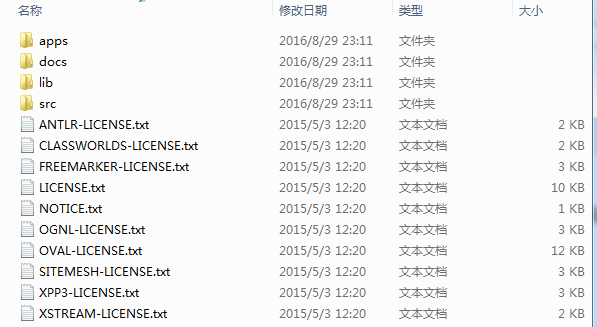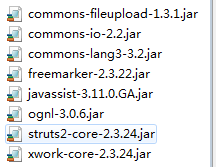一.如何获取Struts2,以及Struts2资源包的目录结构的了解
Struts的官方地址为http://struts.apache.org 在他的主页当中,我们可以通过左侧的Apache Struts菜单下的Release链接,可以查看Struts各个阶段的词资源,也可以通过Archive Site链接访问来获取版本。
那我们这里以struts-2.3.15.1-all为例。

1.App目录下包含了官方提供的Struts2应用示例,为开发者提供了很好的参照。
2.doc目录下是官方提供的Struts2文档。
3.lib目录下是Struts的发行包及其依赖包。
4.src目录是Struts2项目该版本对应的源码。
其余部分是Struts2及其依赖包的使用许可协议和声明。
二.入门案例
1.引入jar包:
新建一个Java Web项目,将Struts2框架所需的jar包添加到项目的lib文件夹上,Struts2项目所依赖的基础jar包如下:

2.创建一个登录案例的界面
01.login.jsp页面
<%@ page language="java" import="java.util.*" pageEncoding="utf-8"%> <% String path = request.getContextPath(); String basePath = request.getScheme() + "://" + request.getServerName() + ":" + request.getServerPort() + path + "/"; %> <!DOCTYPE HTML PUBLIC "-//W3C//DTD HTML 4.01 Transitional//EN"> <html> <!-- 导入Struts2 核心标签库--> <%@taglib uri="/struts-tags" prefix="s"%> <head> <base href="<%=basePath%>"> <title>My JSP 'login.jsp' starting page</title> <meta http-equiv="pragma" content="no-cache"> <meta http-equiv="cache-control" content="no-cache"> <meta http-equiv="expires" content="0"> <meta http-equiv="keywords" content="keyword1,keyword2,keyword3"> <meta http-equiv="description" content="This is my page"> </head> <body> <form action="Login3.action" method="post"> 用户名:<input type="text" name="user.name" /> 密码:<input type="text" name="user.pwd" /> <input type="submit" value="登录"> </form> </body> </html>
02.登录失败页面:final.jsp:

<%@ page language="java" import="java.util.*" pageEncoding="utf-8"%> <% String path = request.getContextPath(); String basePath = request.getScheme() + "://" + request.getServerName() + ":" + request.getServerPort() + path + "/"; %> <!DOCTYPE HTML PUBLIC "-//W3C//DTD HTML 4.01 Transitional//EN"> <html> <head> <base href="<%=basePath%>"> <title>My JSP 'final.jsp' starting page</title> <meta http-equiv="pragma" content="no-cache"> <meta http-equiv="cache-control" content="no-cache"> <meta http-equiv="expires" content="0"> <meta http-equiv="keywords" content="keyword1,keyword2,keyword3"> <meta http-equiv="description" content="This is my page"> </head> <body> <h1>登录失败</h1> </body> </html>
03.登录成功页面scuess.jsp:

<%@ page language="java" import="java.util.*" pageEncoding="utf-8"%> <% String path = request.getContextPath(); String basePath = request.getScheme() + "://" + request.getServerName() + ":" + request.getServerPort() + path + "/"; %> <!DOCTYPE HTML PUBLIC "-//W3C//DTD HTML 4.01 Transitional//EN"> <html> <%@ taglib uri="/struts-tags" prefix="s"%> <head> <base href="<%=basePath%>"> <title>My JSP 'scuess.jsp' starting page</title> <meta http-equiv="pragma" content="no-cache"> <meta http-equiv="cache-control" content="no-cache"> <meta http-equiv="expires" content="0"> <meta http-equiv="keywords" content="keyword1,keyword2,keyword3"> <meta http-equiv="description" content="This is my page"> </head> <body> <h1>登录成功! 欢迎你,<s:property value="user.name"/> </h1> </body> </html>
3.创建cn.entity.User类:

package cn.entity; //用户类 public class User { private String name; private String pwd; public User() { super(); // TODO Auto-generated constructor stub } public User(String name, String pwd) { super(); this.name = name; this.pwd = pwd; } public String getName() { return name; } public void setName(String name) { this.name = name; } public String getPwd() { return pwd; } public void setPwd(String pwd) { this.pwd = pwd; } }
4.创建cn.action.LoginAction类:

package cn.acction; import cn.entity.User; import com.opensymphony.xwork2.Action; import com.opensymphony.xwork2.ActionContext; public class LojinAction implements Action { // 注意User对应必须要有get和set封装不然Strut2框架不会帮你自动装备User对象 private User user; @Override public String execute() throws Exception { // 如果密码为123,用户名为123表示登录成功 if (user.getName().equals("123") && user.getPwd().equals("123")) { // 表示登录成功。 return SUCCESS; } else { // 表示登录失败 return ERROR; } } public User getUser() { return user; } public void setUser(User user) { this.user = user; } }
5.配置web.xml文件:

<?xml version="1.0" encoding="UTF-8"?> <web-app version="2.5" xmlns="http://java.sun.com/xml/ns/javaee" xmlns:xsi="http://www.w3.org/2001/XMLSchema-instance" xsi:schemaLocation="http://java.sun.com/xml/ns/javaee http://java.sun.com/xml/ns/javaee/web-app_2_5.xsd"> <display-name></display-name> <!-- 添加struct2的核心过滤器 --> <filter> <filter-name>struct</filter-name> <filter-class>org.apache.struts2.dispatcher.ng.filter.StrutsPrepareAndExecuteFilter</filter-class> </filter> <filter-mapping> <filter-name>struct</filter-name> <url-pattern>/*</url-pattern> </filter-mapping> <welcome-file-list> <welcome-file>login.jsp</welcome-file> </welcome-file-list> </web-app>
6.在Src目录下创建struts.xml文件:

<?xml version="1.0" encoding="UTF-8" ?> <!DOCTYPE struts PUBLIC "-//Apache Software Foundation//DTD Struts Configuration 2.3//EN" "http://struts.apache.org/dtds/struts-2.3.dtd"> <struts> <!-- 配置文件中只要添加以下配置,那么以后修改配置文件不用重启tomcat --> <constant name="struts.devMode" value="true"/> <package name="default" namespace="/" extends="struts-default"> <!-- 登录案例 --> <action name="Login" class="cn.acction.LojinAction"> <result name="scuess"> Login/scuess.jsp </result> <result name="error"> Login/final.jsp </result> </action> </package> </struts>
执行流程图:

注意点:
1.一定要在web.xml中配置struts2核心过滤器。
2.from表单的action提交的名字要和struts.xml中的action节点的名字保存一致。
3.struts.xml的名字不要写错。
4.表单的input的name属性值不要写错,要写成执行Action类中成员变量的属性名。
